QUARTERLY FUND REVIEW | As of December 31, 2023
By Shawn Gibson on Jan 31, 2024

FUND OVERVIEWS
The Overlay Shares suite of ETFs seeks to provide incremental yield on top of low-cost market beta ETFs by utilizing a highly risk-controlled put spread writing strategy ("the Overlay Strategy") on the S&P 500 Index. We believe the ETFs have the ability to provide higher yield and higher total return than holding the underlying ETFs alone. The Overlay Strategy is applied and managed the same way in all seven of the Overlay Shares funds:
| FUND NAME | BETA EXPOSURE | INCEPTION DATE | GROSS EXPENSE RATIO |
| Overlay Shares Large Cap Equity ETF (OVL) | US Large Cap Equity | 09/30/2019 | 0.80% |
| Overlay Shares Small Cap Equity ETF (OVS) | US Small Cap Equity | 09/30/2019 | 0.84% |
| Overlay Shares Foreign Equity ETF (OVF) | International Equity | 09/30/2019 | 0.99% |
| Overlay Shares Core Bond ETF (OVB) | Broad Investment Grade Bond | 09/30/2019 | 0.80% |
| Overlay Shares Municipal Bond ETF (OVM) | Municipal Bond | 09/30/2019 | 0.84% |
| Overlay Shares Short Term Bond ETF (OVT) | Short Term Corporate Bond | 01/14/2021 | 0.81% |
| Overlay Shares Hedged Large Cap Equity ETF (OVLH) | Hedged US Large Cap Equity | 01/14/2021 | 0.88% |
In addition to generating income through the Overlay Strategy, the Overlay Shares Hedged Large Cap ETF (OVLH) maintains laddered downside hedges to help mitigate risk to the portfolio against significant market drawdowns.
PERFORMANCE OVERVIEW
Renewed concerns around the possibility of "higher for longer" FOMC interest rate policy led to a simultaneous pullback in equities and bonds in the 3rd quarter of 2023. This pullback lingered into the 4th quarter before creating a meaningful bottom in late October.
The strong finish to the year resulted in the S&P 500 Index gaining 11.69% for the quarter, bringing the YTD return to +26.29%. The quarter was even stronger for Small Cap stocks, gaining 15.12% and finishing 2023 +16.05%, significantly underperforming large caps. The US Aggregate Bond Index salvaged a positive year by gaining 6.82% for the quarter, leaving the index +5.53% for the year.
The Overlay Shares were positively impacted by the gains in the various asset class betas and the Overlay helped performance even further with a gain of 1.39% on a gross basis for the quarter, bringing the YTD gross return to 2.37%. As the table below shows, all 7 funds finished positive for the year, with 5 of them beating their benchmarks. The Overlay Shares Large Cap ETF (OVL), Overlay Shares Small Cap ETF (OVS), Overlay Shares Large Cap ETF (OVB), and Overlay Shares Large Cap ETF (OVM) have outperformed their benchmarks since inception despite a poor environment for the Overlay Strategy in 2022. The Overlay Shares Hedged Large Cap (OVLH) continues to meet our expectations, providing investors with significant equity appreciation potential while mitigating downside risk. The risk mitigation for OVLH is designed to defend against market declines that cause significant impairment of capital. OVLH performed well within its peer group for the 4th quarter and the year.
FUND PERFORMANCE
| Q4 23 | YTD | 1 YEAR | 3 YEARS | Inception to Date | |
| OVL NAV Returns | 12.78% | 27.86% | 27.86% | 9.63% | 13.86% |
| OVL Market Price Returns | 12.89% | 28.03% | 28.03% | 9.65% | 13.86% |
| S&P 500 Total Return Index | 11.69% | 26.29% | 26.29% | 10.00% | 13.59% |
| OVS NAV Returns | 16.14% | 17.36% | 17.36% | 6.85% | 9.99% |
| OVS Market Price Returns | 16.27% | 17.28% | 17.28% | 6.90% | 10.01% |
| S&P 600 Total Return Index | 15.12% | 16.05% | 16.05% | 7.28% | 9.78% |
| OVF NAV Returns | 11.39% | 15.62% | 15.62% | 1.33% | 2.77% |
| OVF Market Price Returns | 11.59% | 15.28% | 15.28% | 1.32% | 2.77% |
| MSCI All Country World ex USA Index | 9.75% | 15.62% | 15.62% | 1.55% | 5.63% |
| OVB NAV Returns | 7.86% | 7.08% | 7.08% | -3.46% | -0.16% |
| OVB Market Price Returns | 7.66% | 6.90% | 6.90% | -3.66% | -0.18% |
| Bloomberg US Aggregate Bond Index | 6.82% | 5.53% | 5.53% | -3.31% | -0.63% |
| OVM NAV Returns | 7.90% | 7.13% | 7.13% | -0.44% | 1.59% |
| OVM Market Price Returns | 8.24% | 7.35% | 7.35% | -0.24% | 1.67% |
| Bloomberg Municipal Bond Index | 7.89% | 6.40% | 6.40% | -0.40% | 1.09% |
| OVT NAV Returns | 5.31% | 7.70% | 7.70% | N/A | -0.24% |
| OVT Market Price Returns | 5.41% | 7.73% | 7.73% | N/A | -0.21% |
| Bloomberg US Corporate 1-5 Years TR Index | 4.12% | 6.20% | 6.20% | N/A | -0.04% |
| OVLH NAV Returns | 8.80% | 17.14% | 17.14% | N/A | 5.75% |
| OVLH Market Price Returns | 8.78% | 16.94% | 16.94% | N/A | 5.74% |
| S&P 500 Total Return Index | 11.69% | 26.29% | 26.29% | N/A | 9.72% |
*Inception for OVL, OVS, OVF, OVB, OVM is 09/30/2019. Inception for OVLH and OVT is 01/14/2021.
Performance data quoted represents past performance and is no guarantee of future results. Investment return and principal value of an investment will fluctuate so that an investor's shares, when redeemed, may be worth more or less than their original cost. Current performance may be lower or higher than the performance data quoted. For the most recent month-end performance, please call 1-866-704-OVLS.
Overlay Shares are bought and sold at market price (not NAV) and are not individually redeemed from the Fund. Total Returns are calculated using the daily 4:00pm EST net asset value (NAV). Market price returns reflect the midpoint of the bid/ask spread as of the close of trading on the exchange where Fund shares are listed. Market price returns do not represent the returns you would receive if you traded shares at other times.
MARKET OVERVIEW
The 4th quarter picked up where the 3rd quarter left off, with both equities and bonds taking on further losses. However, starting in the 2nd half of October an intense rally took hold and lasted through most of the quarter. The intensity and magnitude of this rally caught many investors off-guard and underinvested, resulting in a classic short squeeze in December. As the charts below show, the gains from the October lows were quite significant, particularly in small cap stocks:
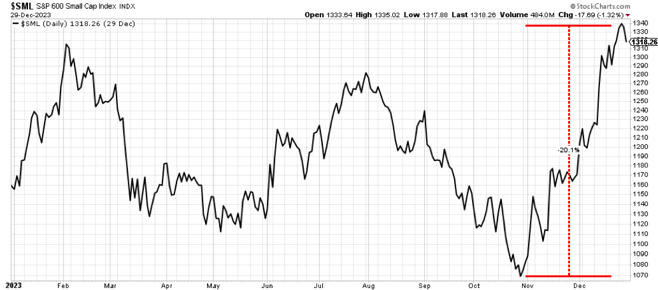
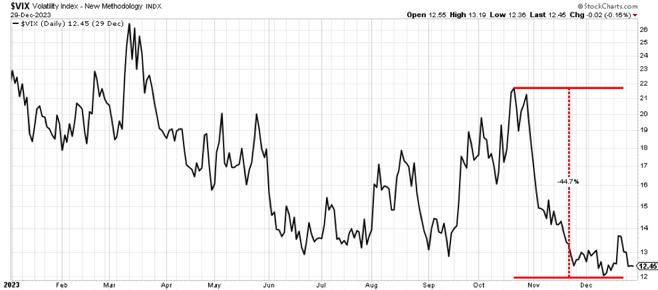
As is the case with most market rallies, equity volatility as measured by the CBOE S&P 500 Volatility Index ("the VIX") collapsed, continuing the overall downward trend. Stable or falling volatility typically serves as a tailwind for the Overlay Strategy.
.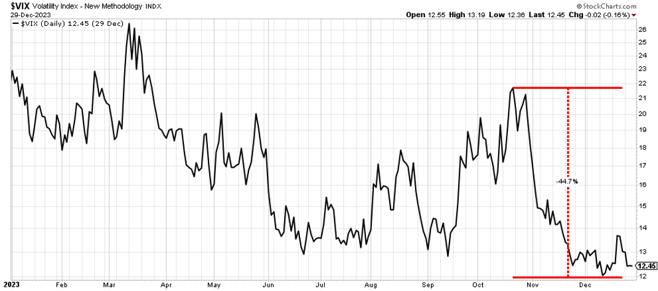
The big story of the year was clearly the prolonged move higher in interest rates followed by their collapse near the end of the year. At one point in October, the 10-year Treasury yield was set to push through 5% as concerns increased around the timing of the FOMC's eventual easing of monetary policy. By the end of the year, the 10-year dropped all the way below 3.9%.

Coming into the New Year, despite the markets appearing to be overbought, there are some signs of optimism that investors might push through any pullbacks that will inevitably come. First, market breadth has improved a lot, meaning that more stocks have been participating in the rally rather than the usual heavy relaince on the "Magnificent 7." Second, investor sentiment has improved significantly although many investors are still underinvested and may continue to be "forced buyers" at some point. Third, the S&P 500 Index has had positive returns in every election year under a new president. However, the 1st quarter of those election years have been the bumpiest, lending credence to the possibility that the year could get off to a choppy start and that market gains could be somewhat back end loaded.
Market Breath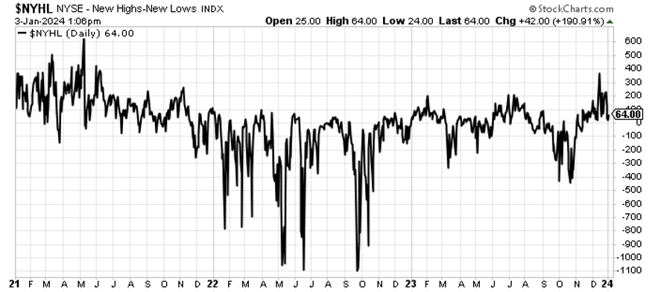
Market Sentiment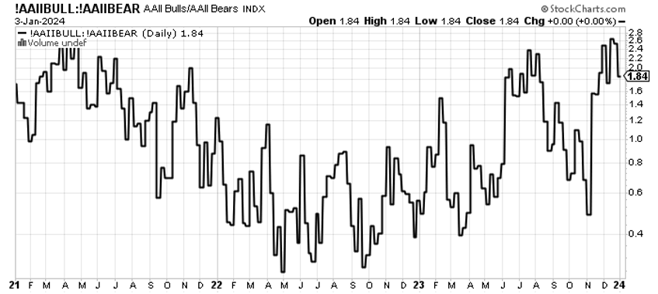

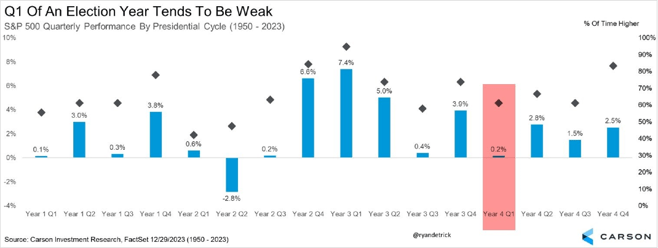
As mentioned in previous letters, equity volatility appears to have moved into a low/normal volatility regime that typically lasts 3-5 years. While these type of volatility regimes can have occasional flare ups in short-term volatility, they tend to come with quiet markets with relatively modest pullbacks and attractive volatility risk premiums (a cornerstone for the success of the Overlay). This type of environment can be very attractive for the Overlay strategy given our approach to option writing and risk management. As such, the high probability outcomes for the Overlay are expected to continue in 2024 and beyond. With that said, market dynamics can change quickly, so we will continue to manage the strategy in a conservative and highly risk-controlled manner.
As always, we are happy to not only do calls and meetings to discuss the performance and outlook for the Overlay, but we are also happy to serve as a resource for general questions on market volatility.
We appreciate your continued support and interest.

Shawn Gibson, Founding Member
Adam Stewart, CFA, Portfolio Manager
OVERLAY SHARES ETFS DISCLOSURES
Performance of less than one year is cumulative. You cannot invest directly in an index.
Overlay Shares are bought and sold at market price (not NAV) and are not individually redeemed from the Fund. Total Returns are calculated using the daily 4:00pm EST net asset value (NAV). Market price returns reflect the midpoint of the bid/ask spread as of the close of trading on the exchange where Fund shares are listed. Market price returns do not represent the returns you would receive if you traded shares at other times.
For a prospectus or summary prospectus with this and other important information about the Fund, please visit the Documents section of this website or call (866) 704-OVLS. Read the prospectus carefully before investing.
Shareholder Services: 1-866-704-OVLS
Investment Professionals: 770-350-8700 or info@overlayshares.com
Distributed by Foreside Fund Services, LLC, which is not affiliated with the Adviser.
RISK FACTORS
The Fund invests in options that derive their performance from the performance of the S&P 500 Index. Selling (writing) and buying options are speculative activities and entail greater than ordinary investment risks. The Fund’s use of put options can lead to losses because of adverse movements in the price or value of the underlying asset, which may be magnified by certain features of the options. When selling a put option, the Fund will receive a premium; however, this premium may not be enough to offset a loss incurred by the Fund if the price of the underlying asset is below the strike price by an amount equal to or greater than the premium. Purchased put options may expire worthless and the Fund would lose the premium it paid for the option. The Fund may lose significantly more than the premiums it receives in highly volatile market conditions.
The Fund will invest in short term put options which are financial derivatives that give buyers the right, but not the obligation, to sell (put) an underlying asset at an agreed-upon price and date. The Fund’s use of options may reduce the Fund’s ability to profit from increases in the value of the underlying asset. The Fund could experience a loss or increased volatility if its derivatives do not perform as anticipated or are not correlated with the performance of their underlying asset or if the Fund is unable to purchase or liquidate a position.
The Fund was recently organized and has no operating history. As a result, investors have a limited track record on which to base their investment decision. Investments involve risk including the possible loss of principal.
S&P 500 Total Return Index - An index of 500 stocks chosen for market size, liquidity and industry grouping, among other factors. The S&P 500 is designed to be a leading indicator of U.S. equities and is meant to reflect the risk/return characteristics of large cap stocks. All cash distributions (e.g. dividends and income) are reinvested. Used as a proxy for "Stocks" above.
Barclay’s U.S. Aggregate Bond Index - A broad-based index of bond securities used to represent investment-grade bonds traded in the U.S. The index was formerly known as the “Lehman Aggregate Bond Index”. Used as a proxy for "Bonds" above.
CBOE Volatility Index ("VIX") - An index sponsored by the Chicago Board of Options Exchange (CBOE) that shows the market's expectation of 30-day volatility. It is constructed using the implied volatilities of various option expirations and various strike prices of S&P 500 index options.
Correlation (R2) - A statistical measure of how two financial instruments (e.g. securities, indices, etc.) move in relation to each other. A correlation of +1 implies that as one security moves, either up or down, the other security will move in lockstep, in the same direction. Alternatively, the closer correlation is to 0, the less the movements of two securities are related to one another.
Beta - A measure of the portfolio’s sensitivity to changes in the benchmark. A beta of 1 indicates the portfolio has historically moved with the benchmark. A portfolio beta greater than 1 indicates the portfolio has been more volatile than the benchmark and a portfolio beta less than one indicates the portfolio has been less volatile than the benchmark. Beta in this presentation is calculated using monthly historical returns.
Sharpe Ratio - A measure for calculating risk-adjusted return. The Sharpe ratio is the average return earned in excess of the risk-free rate per unit of volatility or total risk. Subtracting the risk-free rate from the mean return, the performance associated with risk-taking activities can be isolated. Sharpe ratio = (Mean portfolio return − Risk-free rate)/Standard deviation of portfolio return. For Sharpe Ratio calculations in this presentation, the “risk free rate” is represented by the annualized monthly returns of the 3 Month US T-Bill.
Max Drawdown - A measure of the largest single drop from peak to trough based on monthly portfolio returns
HFRX Absolute Return Index - A stock index designed to measure absolute returns. The absolute return index is actually a composite index made up of five other indexes. This index is used to compare the absolute returns posted by the hedge fund market as a whole against individual hedge funds.
Standard Deviation - A measure of the dispersion of a set of data from its mean.
- October 2025 (3)
- August 2025 (1)
- July 2025 (3)
- May 2025 (1)
- April 2025 (7)
- March 2025 (2)
- February 2025 (1)
- January 2025 (1)
- November 2024 (1)
- October 2024 (1)
- July 2024 (2)
- April 2024 (1)
- January 2024 (1)
- November 2023 (1)
- October 2023 (1)
- August 2023 (1)
- July 2023 (1)
- April 2023 (1)
- January 2023 (1)
- November 2022 (1)
- October 2022 (2)
- July 2022 (1)
- April 2022 (1)
- March 2022 (2)
- February 2022 (3)
- January 2022 (3)
- November 2021 (1)
- October 2021 (3)
- September 2021 (1)
- July 2021 (1)
- May 2021 (1)
- April 2021 (1)
- March 2021 (3)
- January 2021 (3)
- December 2020 (3)
- October 2020 (3)
- September 2020 (2)
- August 2020 (4)
- July 2020 (6)
- June 2020 (4)
- May 2020 (4)
- April 2020 (4)
- March 2020 (14)
- February 2020 (9)
- January 2020 (3)
- December 2019 (1)
- November 2019 (1)
- October 2019 (1)
- July 2019 (1)
- April 2019 (1)
Subscribe
You May Also Like
These Related Posts

QUARTERLY FUND REVIEW | As of September 30, 2023

QUARTERLY FUND REVIEW | As of September 30, 2025

